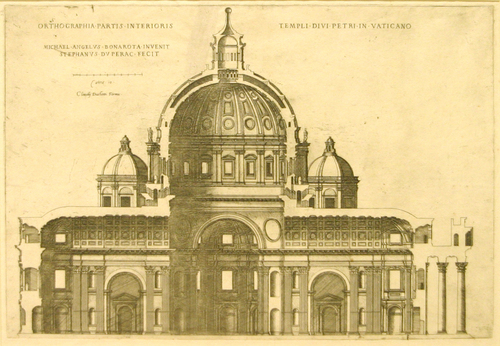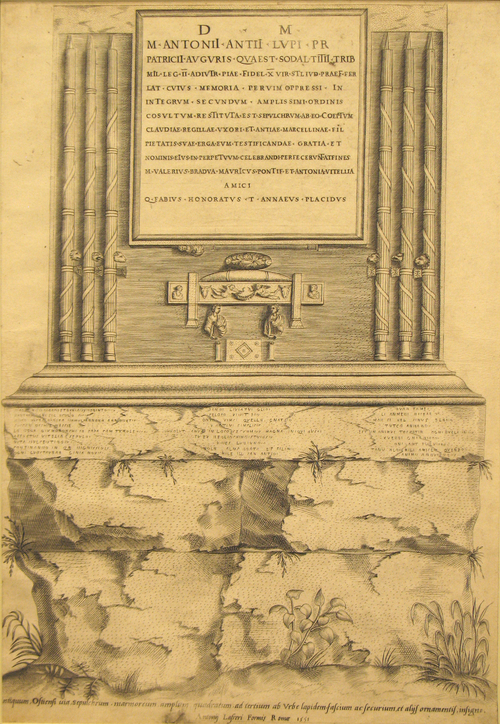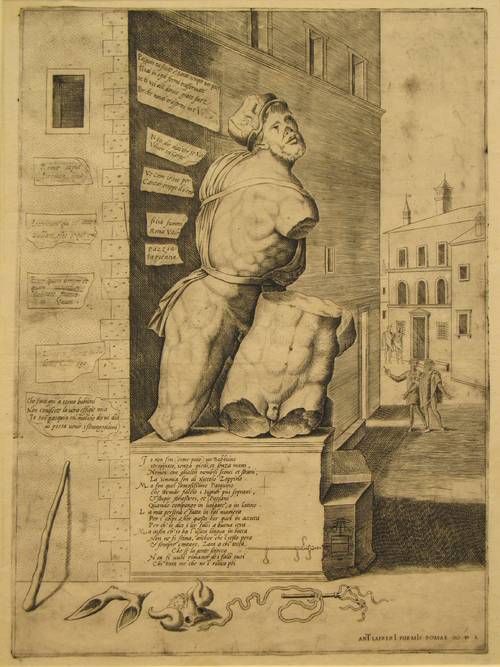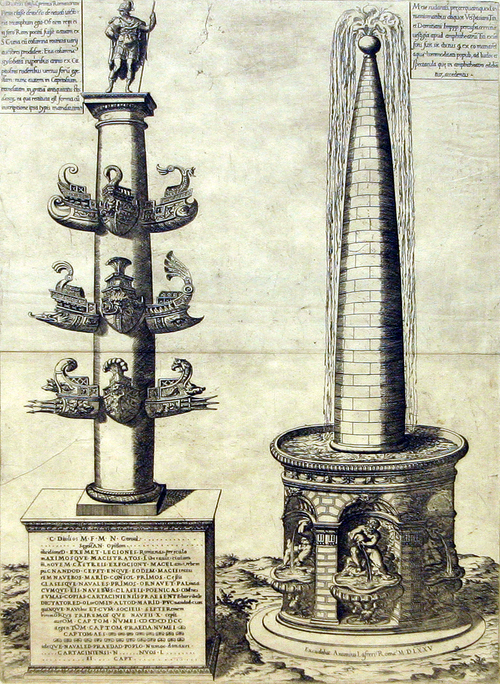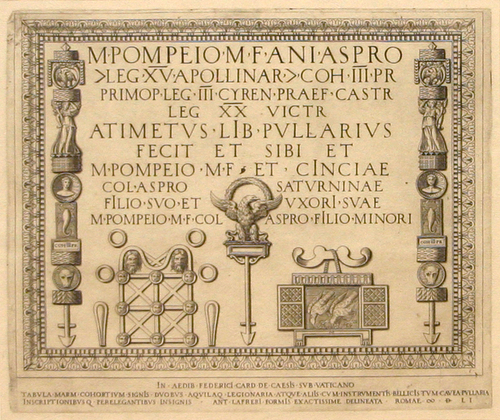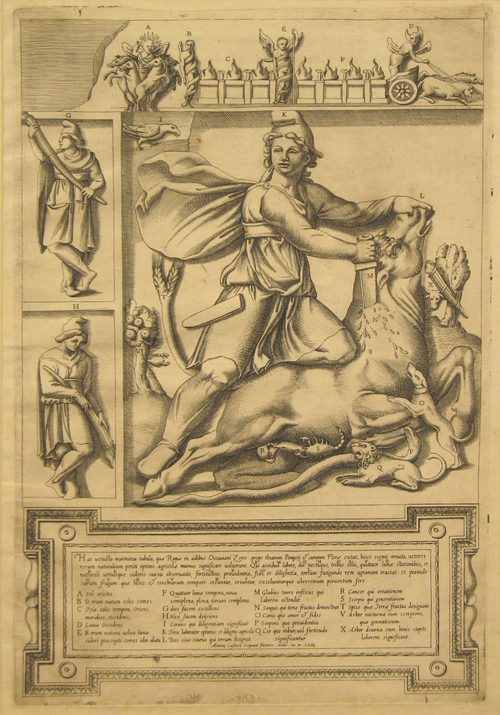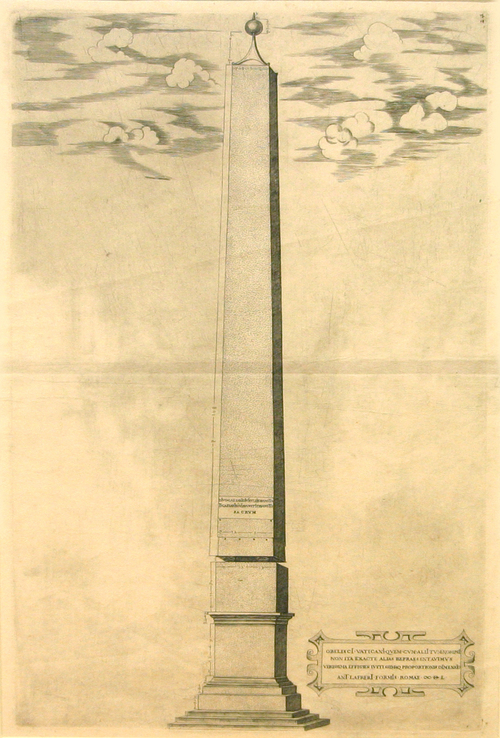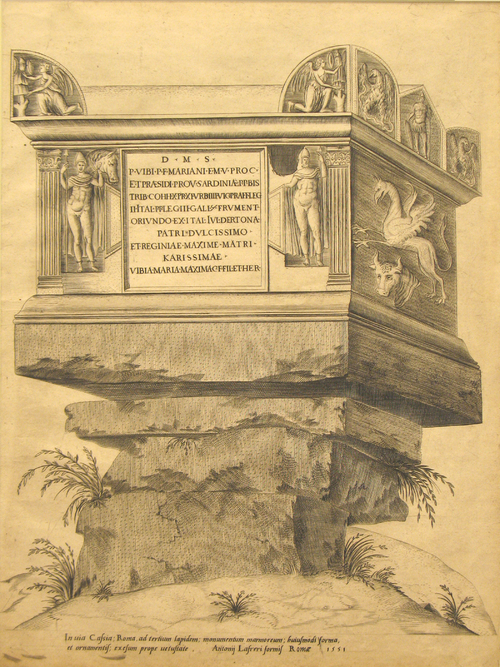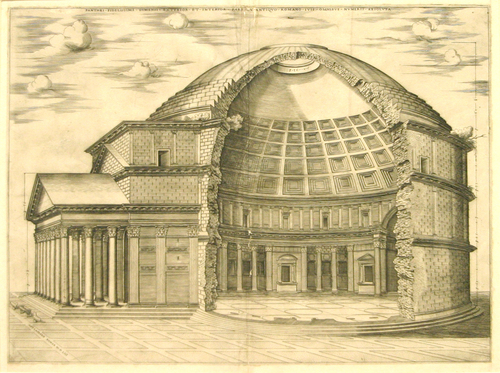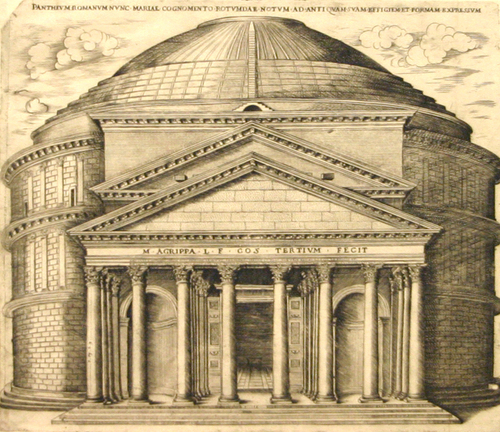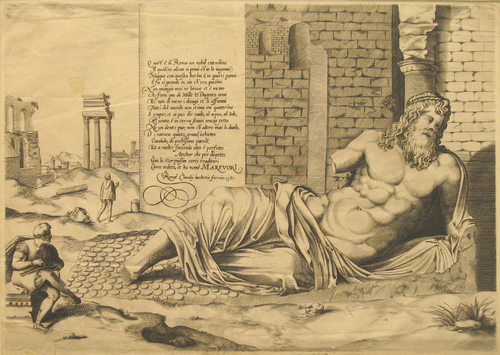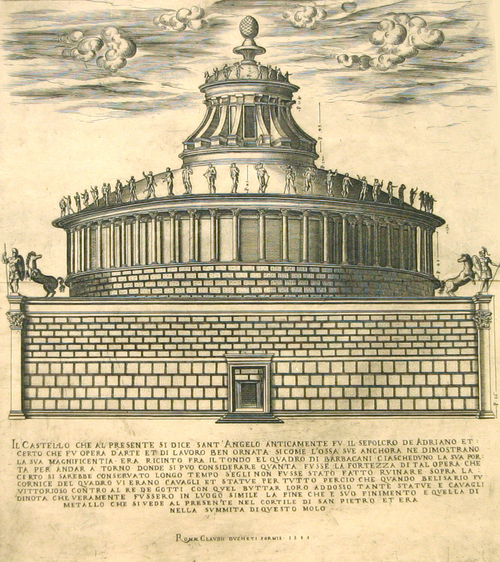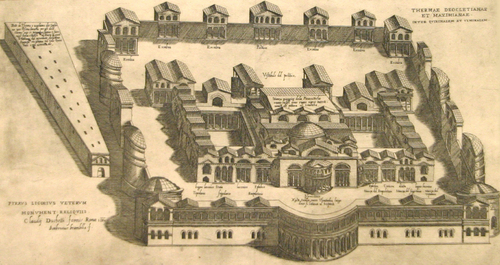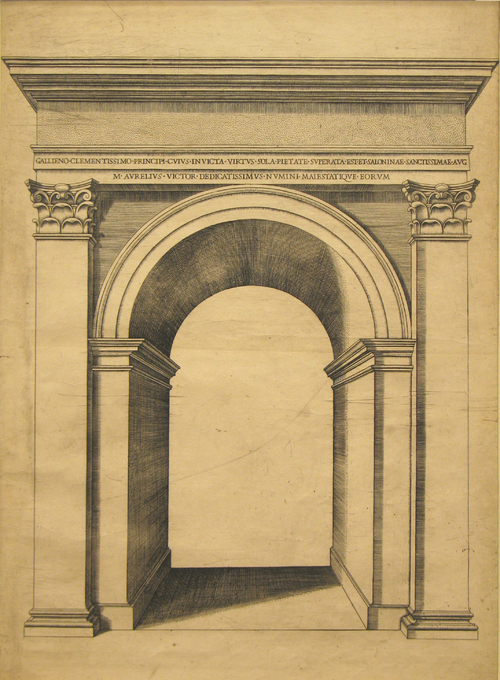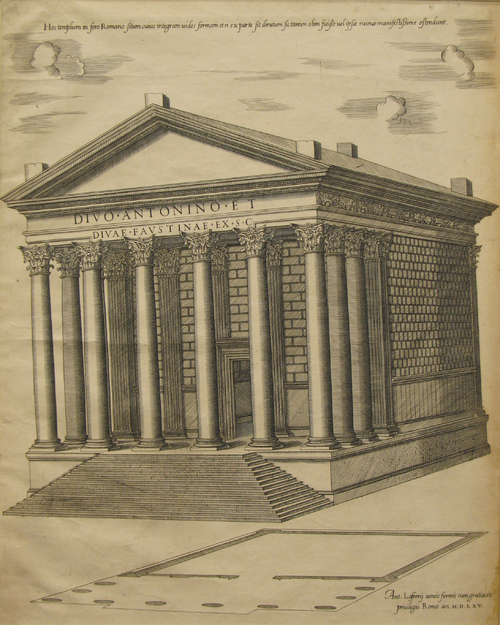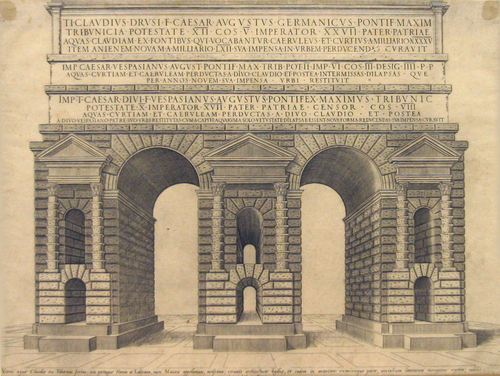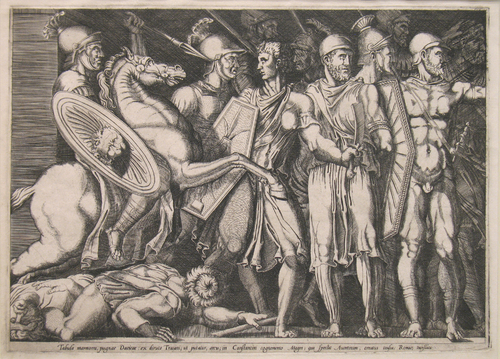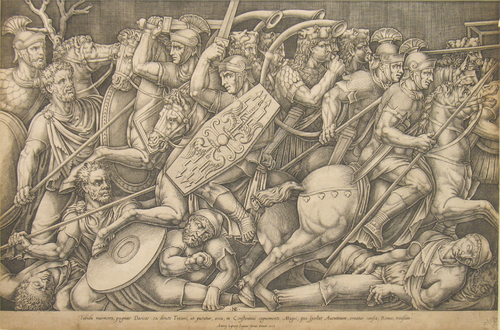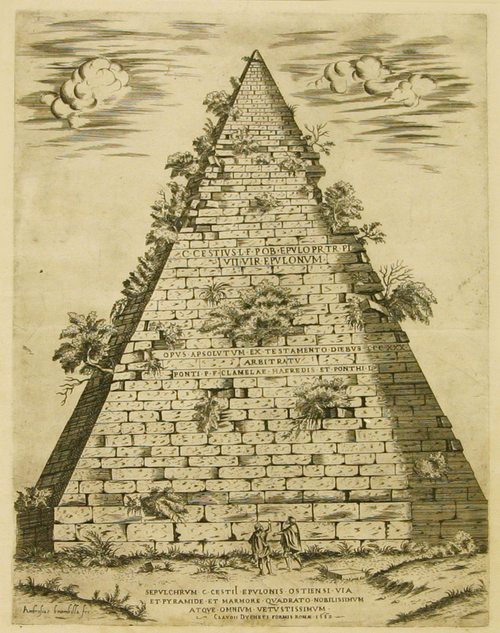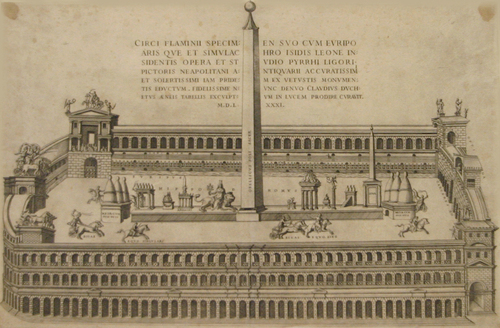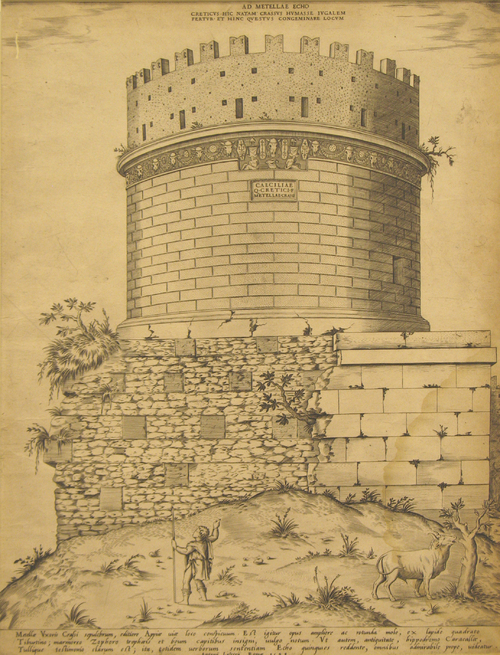Selections from the Speculum Romanae Magnificentiae, 16th century
Erin Sutherland
Independent art historian
During the sixteenth century, collectors eagerly sought prints of crumbling ruins, imaginatively restored sites, and the architectural marvels of Rome. The engravings, which publishers tailored to specific audiences, demonstrate how viewers related to the urban landscape of Rome during the Renaissance. Publishing a single page with the title Speculum Romanae Magnificentiae (Mirror of Roman Magnificence) around 1575, Antonio Lafreri (1512–1577) encouraged collectors to compile albums of impressions. As the prints in the collection of the Mildred Lane Kemper Art Museum demonstrate, engravings now known collectively as the Speculum range broadly in style, date, and subject. There was such a demand for the Speculum that printers commonly reused or recut printing plates obtained from other publishers, either introducing significant revisions in the process or leaving images virtually unchanged. Although previous scholarship has not focused on the modifications evident in republished prints, these changes demonstrate strategic efforts by publishers to appeal to different, and broader, audiences. Each of the impressions discussed in this essay was printed from a newly engraved plate by a secondary publisher, with varying degrees of alteration. This new perspective, here applied to four case studies, demonstrates what insight can be gleaned from the changes a publisher introduced to a reissued print. I consider the significance of these changes and address how the reissued prints appealed to different types of collectors, including antiquarians, artists, travelers, and architects.
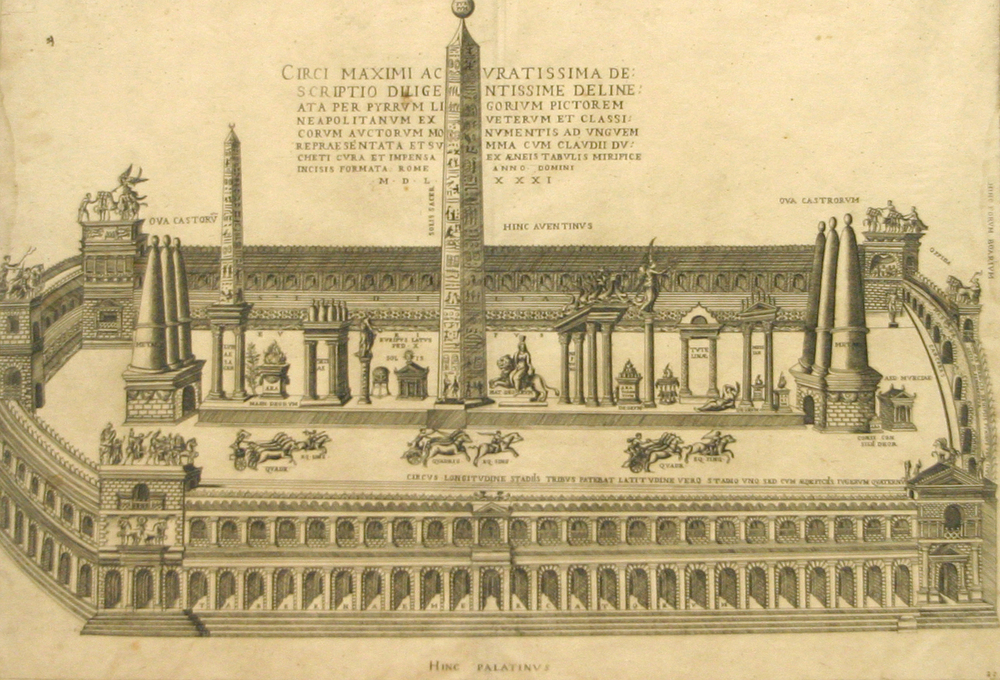
Following Antonio Lafreri’s death in 1577, his nephew Claudio Duchetti (1554–1597) largely took over his successful business. Duchetti continued to print from Lafreri’s plates, and some from other publishers, commissioning new plates when the originals wore out from heavy use.1 One print is an imaginatively reconstructed view of the Circus Maximus showing the fully intact ancient site complete with horses, riders, and charioteers charging around the track. The impression was engraved by Ambrogio Brambilla (active c. 1579–1599) and published by Claudio Duchetti in 1581. This work by Brambilla is based closely on a print designed by the antiquarian Pirro Ligorio (c. 1500–1583) in 1553.2 That earlier print of the Circus Maximus incorporates a lengthy inscription detailing Ligorio’s ancient sources, which include classical texts and ancient coins with images of the circus. The publisher, Michele Tramezzino (1526–1571), clearly intended the print to appeal to the coterie of antiquarians and scholars that made his book and print shop a well-known gathering place for the intelligentsia of Rome.3 These dedicated classicists would have eagerly juxtaposed the ancient descriptions of the Circus Maximus with Ligorio’s image. The inscription on the Brambilla/Duchetti print at the Kemper Art Museum has been edited from the original 226 words to just forty, citing Ligorio as a source for the image, without specifying which ancient texts he consulted. Duchetti’s less esoteric print thus appealed to the broader audience that frequented his print shop, without excluding antiquarian collectors. This is indicative of the changing print market, which expanded beyond specialists during the 1550s to include less academic audiences in the 1580s.

Artist Sketching Marforio, published in 1581 by Claudio Duchetti, is another example of this trend to attract more diverse collectors—it appealed to artists. In the print we see the battered sculpture of Marforio in the Forum Romanum. An artist, with a sketchbook balancing on his knee, sits a few feet away, drawing the ancient sculpture; another figure explores nearby ruins. Marforio was one of the “speaking statues” of Rome, to whom disgruntled citizens surreptitiously attached biting criticisms, generally to expose incompetence or corruption among ecclesiastic or civic officials.4 On the wall behind the sculpture in the print, a poem introduces the aged, battered Marforio as a soft-spoken yet candid citizen of Rome, eager to voice the truth. Inclusion of the poem indicates the audience’s interest in the afterlife of the sculpture. The urban context of ruins and a distant medieval tower, as well as the two figures, show that this is a contemporary view.
Duchetti’s Artist Sketching Marforio is modeled on a print published by Lafreri in 1550 that also includes four simple rectangular ancient monuments awkwardly displayed in front of Marforio. These monuments, which are adorned only with inscribed tributes to Roman emperors, may have piqued the interest of some devoted antiquarians and epigraphers, but they cluttered the composition.5 Three decades after Lafreri’s publication, Duchetti revised the image to omit the monuments in favor of a less contrived scene and greater emphasis on the contemporary view of Marforio. As with the Circus Maximus print, Duchetti’s Marforio no longer assumes that viewers are interested in obscure antiquarian monuments or ancient texts. Rather it engages viewers with ancient sculptures by emphasizing the contemporary setting.
The seated figure next to Marforio activates the scene and contributes to a stronger connection with the viewer than is the case with most Speculum prints. The young man also calls attention to an important audience for prints of all types during the Renaissance: other artists. Here he calls to mind several ways artists and prints relate to one another. While he reminds the viewer of artists sketching throughout the city en plein air, he also suggests the Renaissance artist using the engraving. Artists collected prints for three central reasons: They studied ancient sculptures and structures from prints, they gathered printed or drawn models for use in their own works, and they copied prints to hone their draftsmanship skills.6 Prints were so strongly associated with artists that the draftsman sketching Marforio should be seen as a direct acknowledgment of this audience.
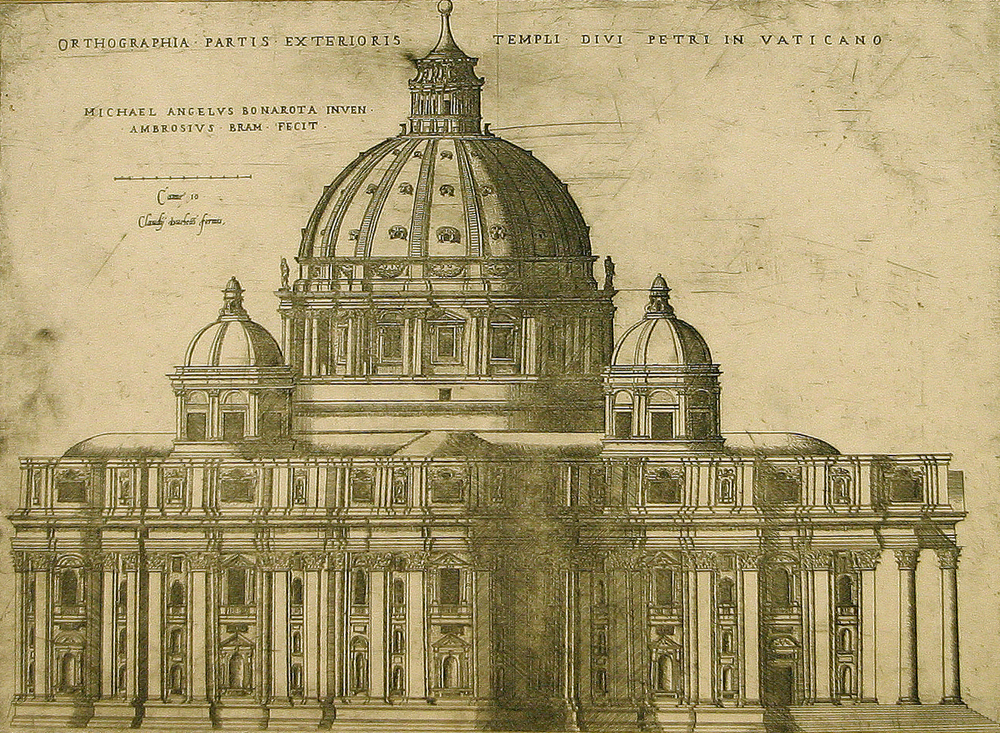
While the Marforio engraving, with its informality and inclusion of contemporary figures, is atypical, the The Arch of Constantine published by Claudio Duchetti in 1583 is more characteristic of the Speculum. Lafreri previously published a print nearly identical to Duchetti’s Arch of Constantine. The original plates were worn out from heavy use, and the popularity of the print made revisions to the design unnecessary in the recut plates. Such highly detailed, carefully measured studies responded to a widely recognized need to document the antiquities of Rome for posterity. The arch exists in an artificial space, divorced from any urban context, with a checkerboard ground plane. Crisp, precise lines articulate forms while subtle shadows create modeling. The monument is carefully measured and accurately represented while even fine details of the surface ornaments are evident. In many ways this mode of representation suggests a specimen, isolated and presented for study. The print is primarily a means to convey as much accurate, detailed information as possible about the arch, without suggesting artistic interpretation.
A compelling need for precise visual documentation of antiquities is best expressed by Raphael in a letter to Pope Leo X, written around 1519.7 Raphael voiced concern for Rome because ruin, spoliation, and exploitation of antiquities gravely endangered the ancient fabric of the city. He unsuccessfully implored the pontiff to hire him for a large-scale commission to measure and draw the ancient monuments of the Eternal City. He insisted that his drawings would, to some extent, mitigate the tragic loss of Rome’s classical past. At that time, documentation of ancient monuments was limited to artists’ sketches and a few rudimentary prints. Twenty years after Raphael wrote his letter, Lafreri’s prints addressed ongoing, widespread concerns about the destruction of Rome. In The Arch of Constantine and similar prints, visual preservation through precise documentation is critical. Duchetti’s decision not to change the print indicates that the style and subject responded well to an enduring need for measured images based on careful surveying and study.
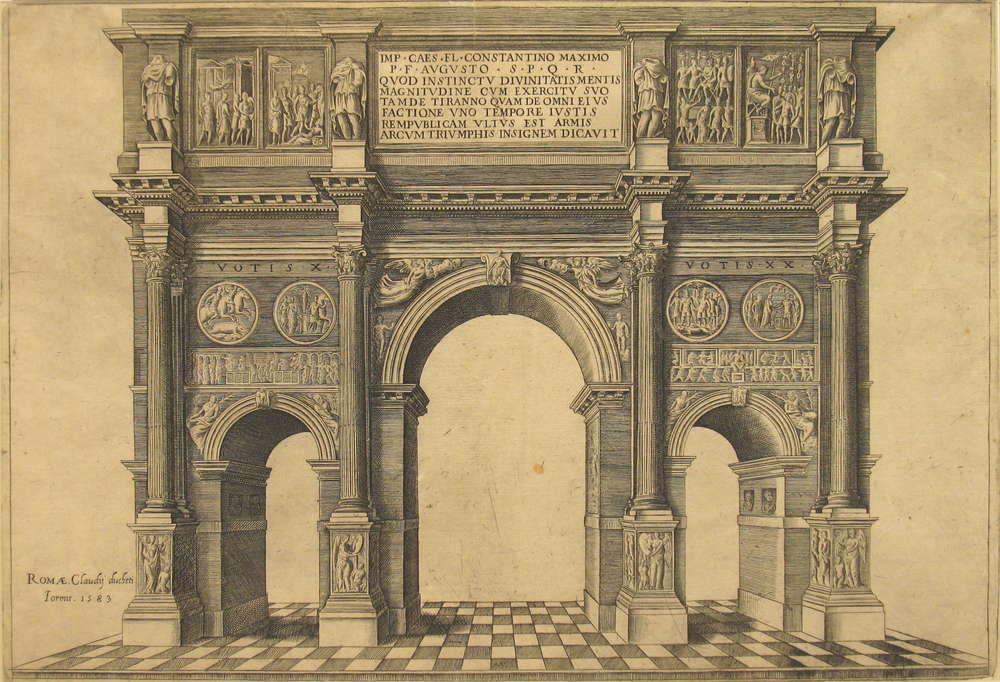
Another architectural print that remained unchanged when reissued by a secondary publisher offered a glimpse not of Rome’s past, but of its future. Around 1581–86, Ambrogio Brambilla engraved new printing plates of St. Peter’s Basilica, Michelangelo’s Project, Exterior View to replace worn plates of a nearly indistinguishable engraving by Etienne Dupérac (c. 1525–1604), from c. 1569. Clearly Brambilla saw no advantage to changing the image, which appealed to the constant flow of tourists through the city as well as to a narrower audience of architects. Since the beginning of the ambitious project for a monumental new basilica, proposed in 1506 by Donato Bramante, the apostolic sepulchre was engulfed by the largest construction site in Europe.8 After a succession of architects modified the project, Michelangelo became chief architect of St. Peter’s in 1546.9 Brambilla’s print shows the exterior of Michelangelo’s intended structure from the side, with the front portico on the right edge of the composition.10 The style is clear and highly detailed. Unlike the Arch of Constantine print, the St. Peter’s Basilica engraving includes sweeping shadows that suggest natural sunlight and anchor the building in a physical environment. The rhythmic play of light and shade emphasizes the undulating contours and sculptural surface. Although the finished basilica did not yet exist, it appears tangible and dynamic. Visitors to Rome, curious about the massive undertaking at the Vatican, sought prints that suggested how the completed structure would look. The representation of the future basilica as an existing building, rather than an architectural design, engaged these collectors.
Unlike travelers, architects eager to collect the Speculum were less concerned with style than with gathering professional resources. They relied on these images for study, inspiration, and documentation of architectural features to incorporate into their own designs. Every established and aspiring architect needed to know the design of New St. Peter’s. Just as artists could use the Marforio print to study ancient sculptures, architects compiled visual compendia of Rome’s structures by visiting print shops rather than surveying and sketching throughout the city. In the 1440s Leon Battista Alberti proposed that architects should study classical buildings to understand the aesthetics and the engineering principles of the ancients.11 Ideally, architects would emulate the accomplishments of antiquity and even exceed them. The print of the new St. Peter’s demonstrates the realization of this objective. Michelangelo’s design is strikingly innovative in scale, layout, and surface ornament, yet it is thoroughly imbued with the spirit and architectural vocabulary of antiquity. Seen alongside, or bound together with, prints of classical structures, the St. Peter’s Basilica engraving creates a visual dialogue between Rome’s architectural past and present, calling attention to stylistic continuity.
Just as Renaissance viewers benefitted from the examination of multiple Speculum prints, we gain new insights by studying many works. These four prints provide an opportunity for such comparative analysis, suggesting the broad range of audiences that collected the Speculum during the 1580s such as the antiquarians, artists, tourists, and architects discussed here. While the Circus Maximus and Marforio prints indicate that Claudio Duchetti repeatedly altered images to remove the details that appealed predominately to antiquarian specialists, the Arch of Constantine and St. Peter’s Basilica prints demonstrate that some images had such broad, enduring appeal that publishers chose not to alter them when engraving new plates. The fact that each of these impressions is a secondary print calls attention to the prevalence and value of reissued engravings, which warrants more attention in future scholarship. Additional analysis of reissued prints could include a larger sample to track trends in artistic style and collectors’ interests. These four impressions, as a group, reveal the particular value of reissued prints as part of a broader discussion of print culture in Renaissance Rome.
- 1 Valeria Pagani, “The Dispersal of Lafreri’s Inheritance, 1581–89,” Print Quarterly 25, no. 1 (March 2008): 3–23.
- 2 Ligorio’s design was engraved by Nicolas Beatrizet (1515–1565). See Christopher L. C. E. Witcombe, Print Publishing in Sixteenth-Century Rome (London: Brepols, 2008), 147–52.
- 3 On the collaboration of Ligorio and Tramezzino, see David R. Coffin, Pirro Ligorio: The Renaissance Artist, Architect, and Antiquarian (University Park, PA: Penn State University Press, 16–19.
- 4 Phyllis P. Bober and Ruth O. Rubinstein, Renaissance Artists and Antique Sculpture, 2nd ed. (London: Brepols, 2010), 110–11. See also Francis Haskell and Nicholas Penny, Taste and the Antique: The Lure of Classical Sculpture (New Haven, CT: Yale University Press, 1981), 258–59.
- 5 The monuments honor the Augustan peace, Vespasian, and Constantine II.
- 6 For example, the young Michelangelo copied and colored a print by Martin Schongauer. See Giorgio Vasari, Le vite de’ più eccellenti pittori, scultori e architettori nelle redazioni del 1550 e 1568 (Florence: Sansoni, 1987), 6:8, and Ascanio Condivi, Vita di Michelangelo Buonarroti, ed. Giovanni Nencioni (Florence: Studio per Edizioni Scelte, 1998), 9. For more on artists’ workshop use of prints, see Catherine King, “Drawing and Workshop Practices,” in Making Renaissance Art, ed. Kim W. Woods (London: Yale University Press, 2007), 28–29, and Charles Harrison, “The Printed Picture in the Renaissance,” in ibid., 238–39.
- 7 Translated and published in Vaughan Hart and Peter Hicks, eds., Palladio’s Rome: A Translation of Andrea Palladio’s Two Guidebooks to Rome (New Haven, CT: Yale University Press, 2006), 177–92. The concept of engravings as contributing to the public good is explored in Rebecca Zorach, “The Public Utility of Prints,” in her The Virtual Tourist of Renaissance Rome (Chicago: University of Chicago Press, 2008), 63–83.
- 8 On the complicated construction process, see Christof Thoenes, “Renaissance St. Peter’s,” in St. Peter’s in the Vatican, ed. William Tronzo (Cambridge: Cambridge University Press, 2005), 64–92, and Henry A. Millon, “Michelangelo to Marchionni, 1546–1784,” in ibid., 93–110.
- 9 On Michelangelo’s project for New St. Peter’s, see James S. Ackerman, The Architecture of Michelangelo, 2nd ed. (Chicago: University of Chicago Press, 1986), 193–220, and Giulio Carlo Argan and Bruno Contardi, Michelangelo Architect, trans. Marion L. Grayson (New York: Harry N. Abrams, 1993), 322–35. For more prints of Michelangelo’s plan, see Bernadine Barnes, Michelangelo in Print (Burlington, VT: Ashgate, 2010), 131–36.
- 10 After Michelangelo’s death, Giacomo della Porta elongated the profile of the dome, and Carlo Maderno changed the centrally-planned church to a longitudinal one, so the print does entirely not match the finished basilica.
- 11 Joan Gadol, Leon Battista Alberti: Universal Man of the Early Renaissance (Chicago: University of Chicago Press, 1969), 98–99, 104–6.
